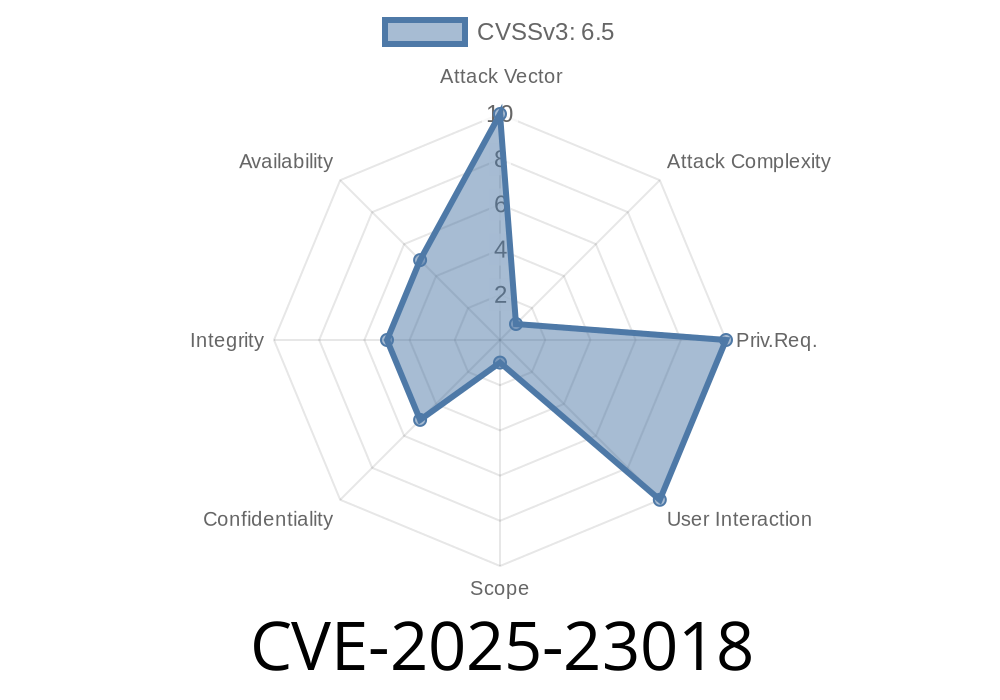In today's interconnected world, the security of computer systems and networks is of utmost importance. One area of concern is the vulnerabilities in the communication between different systems using various Internet Protocol (IP) versions. In this informative post, we will discuss a critical vulnerability (CVE-2025-23018) that affects IPv4-in-IPv6 and IPv6-in-IPv6 tunneling (as defined in RFC 2473) and allows an attacker to manipulate the flow of network traffic. This vulnerability shares similarities with CVE-202-10136.
Background
IPv4-in-IPv6 and IPv6-in-IPv6 tunneling, as defined in RFC 2473, is a technique used to transport IPv4 or IPv6 packets over an IPv6 network, respectively. The purpose of this tunneling mechanism is to facilitate the coexistence of both IPv4 and IPv6 networks and to ease the transition from IPv4 to IPv6.
The Vulnerability
The vulnerability CVE-2025-23018 resides in the improper validation of the source of a network packet in the IPv4-in-IPv6 and IPv6-in-IPv6 tunneling. This vulnerability allows an attacker to spoof and route arbitrary traffic via an exposed network interface, exploiting the fact that RFC 2473 does not require the validation or verification of the originating source of the network packet.
This vulnerability is very similar to CVE-202-10136 (reference), which also affects the handling of network traffic in IPv4-in-IPv6 tunneling. In both cases, if the validation and verification of the source of a network packet get bypassed, an attacker can send arbitrary traffic to vulnerable systems, potentially bypassing security controls such as firewalls and intrusion detection systems.
The Exploit
To exploit this vulnerability, an attacker needs to craft a specially designed IPv4 or IPv6 packet, encapsulate it within an IPv6 packet, and then send it to the vulnerable tunneling mechanism. The specially designed packet will have the following characteristics:
Here's a code snippet that demonstrates the generation and encapsulation of IPv4-in-IPv6 packet
import socket
import struct
from ipaddress import IPv6Address
# Specially crafted IPv4 packet
src_ip = '192..2.1'
dst_ip = '192..2.2'
ipv4_packet = struct.pack('!4s4s', socket.inet_aton(src_ip), socket.inet_aton(dst_ip))
# Encapsulation within IPv6 packet
src_ipv6 = '2001:db8::1'
dst_ipv6 = '2001:db8::2'
ipv6_packet = struct.pack('!16s16s4s', IPv6Address(src_ipv6).packed, IPv6Address(dst_ipv6).packed, ipv4_packet)
# Send the packet to the vulnerable tunneling mechanism...
Upon receiving such a packet, the vulnerable tunneling mechanism will not validate or verify the originating source of the network packet, enabling the spoofed packet to be processed and forwarded to the targeted system.
Mitigation
To mitigate this vulnerability, it is crucial to enforce proper validation and verification of the originating source of network packets in the affected tunneling mechanism. In addition, implementing security controls such as ingress filtering can help prevent spoofed packets from entering the network. It's also essential to keep network devices and systems patched with the latest security updates and follow the best security practices advised by professionals.
Conclusion
The CVE-2025-23018 vulnerability involving IPv4-in-IPv6 and IPv6-in-IPv6 tunneling serves as a reminder of the importance of proper packet validation in IP networks. Understanding the exploit details and implementing necessary mitigation steps can help ensure a more secure and resilient network infrastructure.
Timeline
Published on: 01/14/2025 20:15:32 UTC
Last modified on: 01/29/2025 18:01:47 UTC
